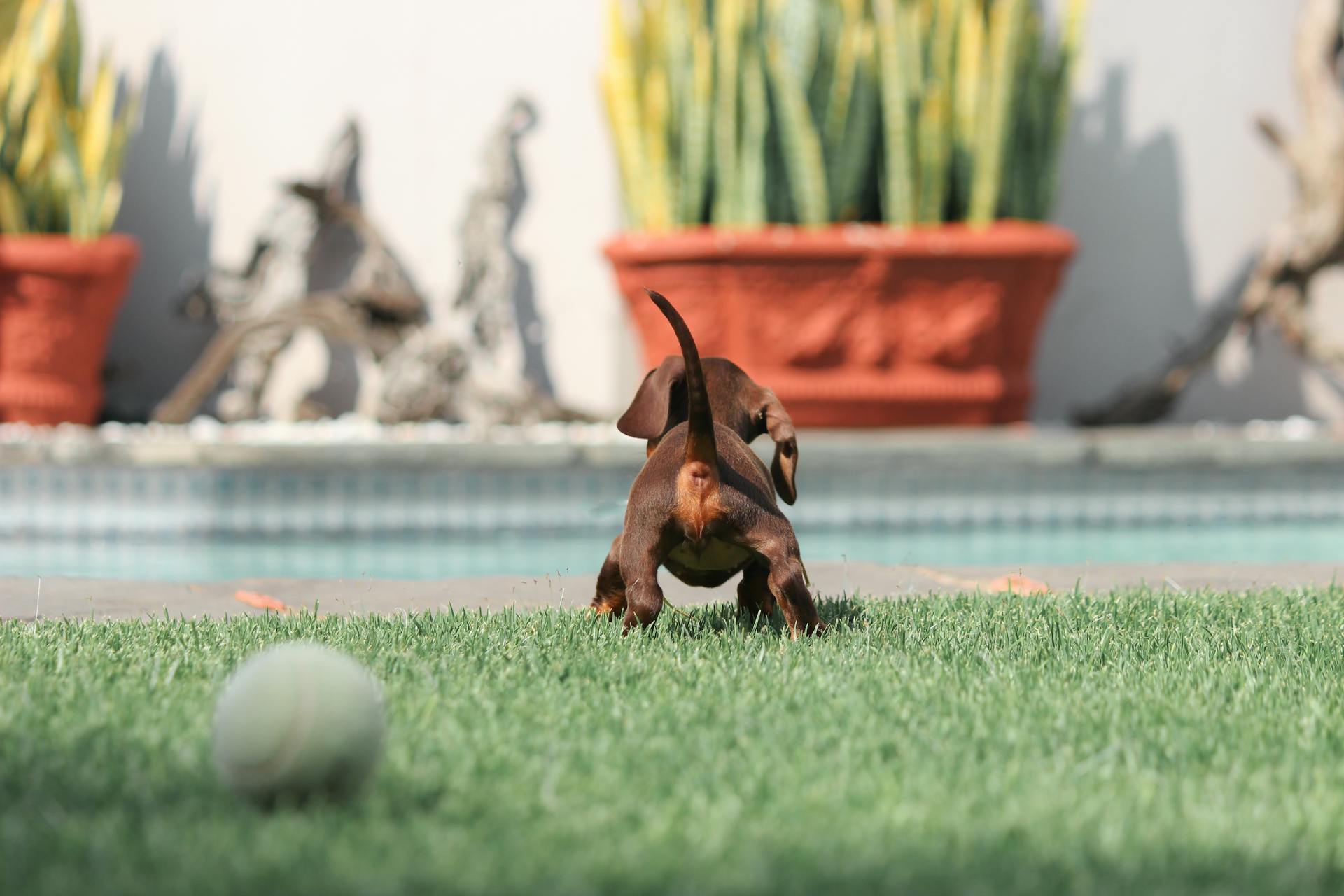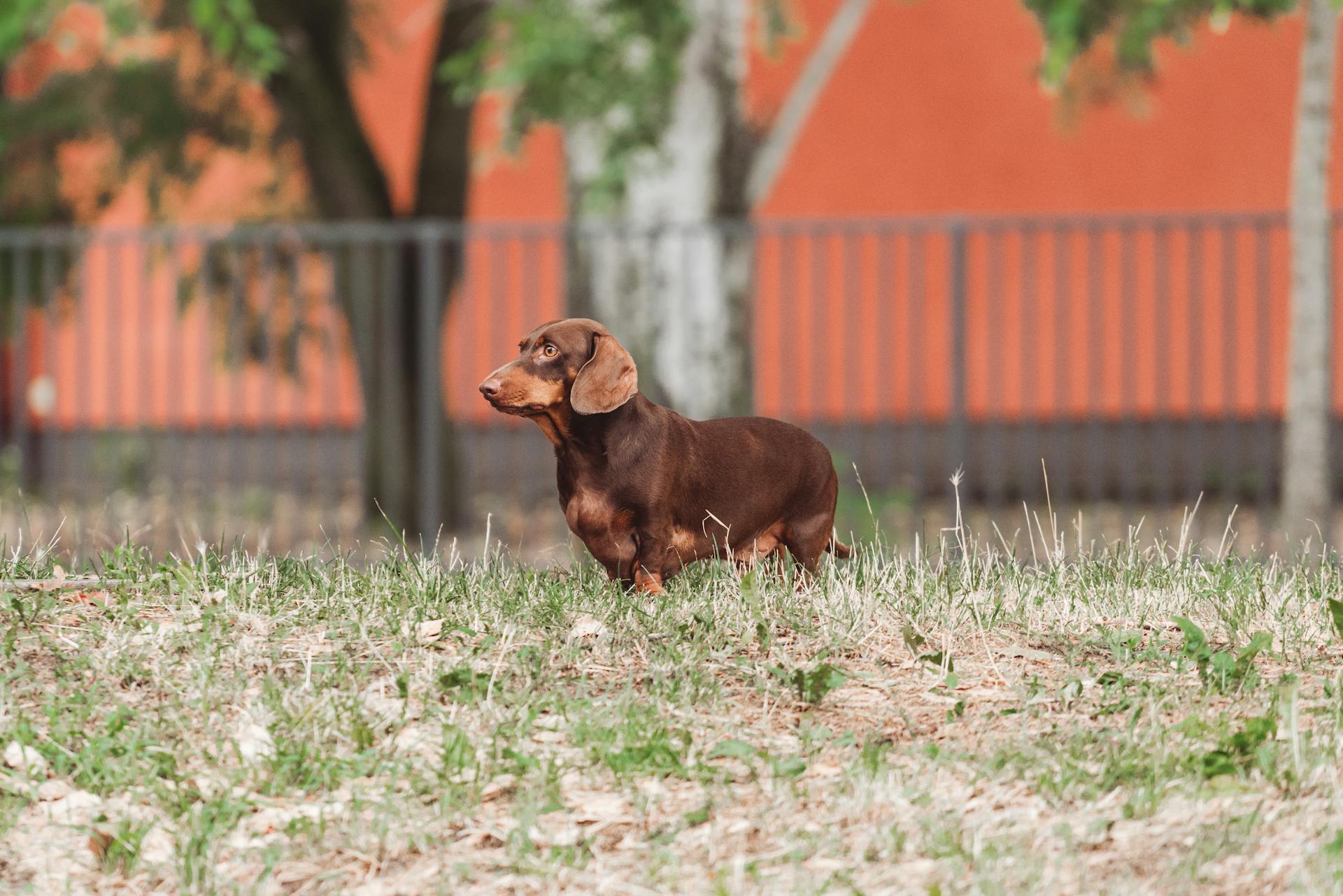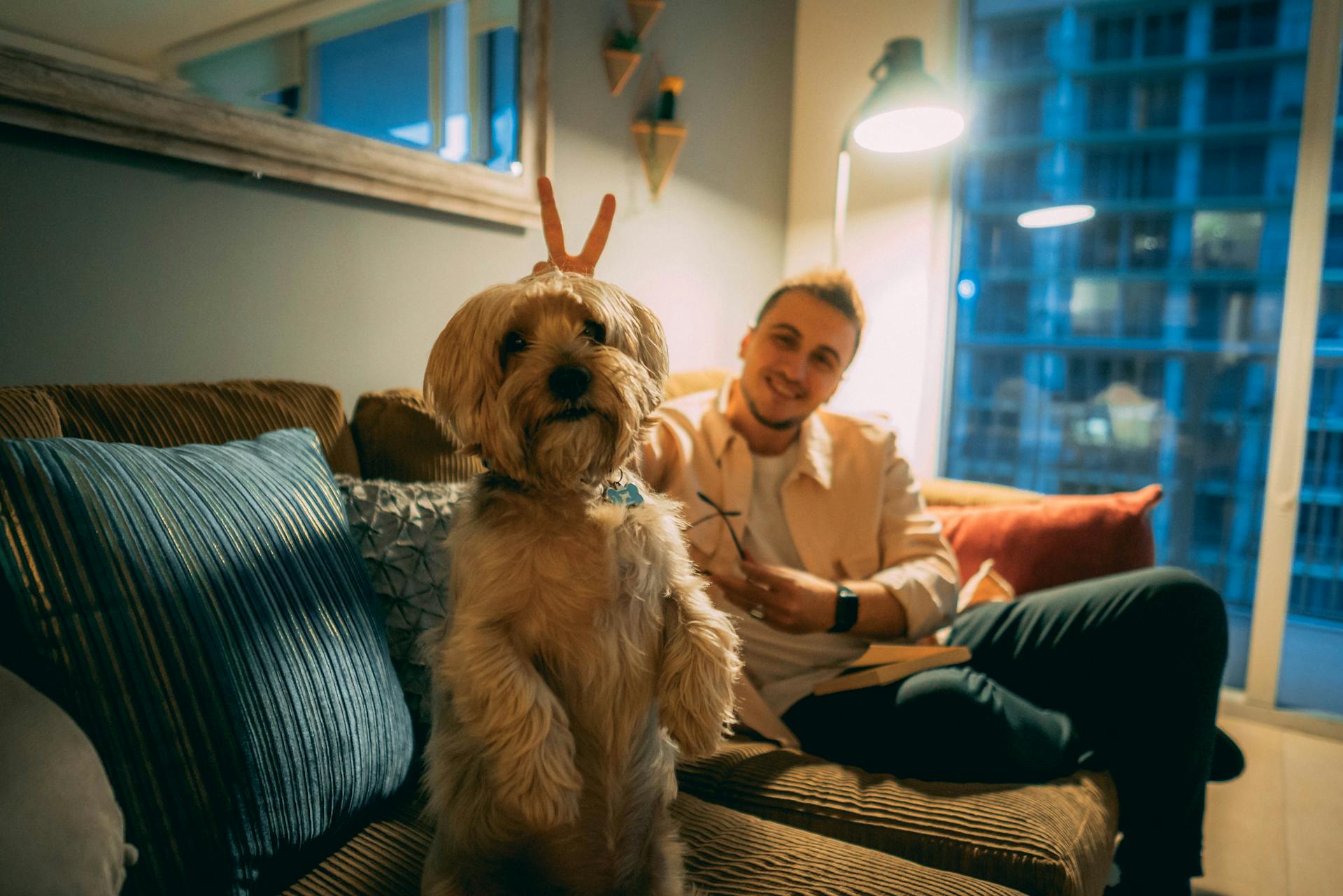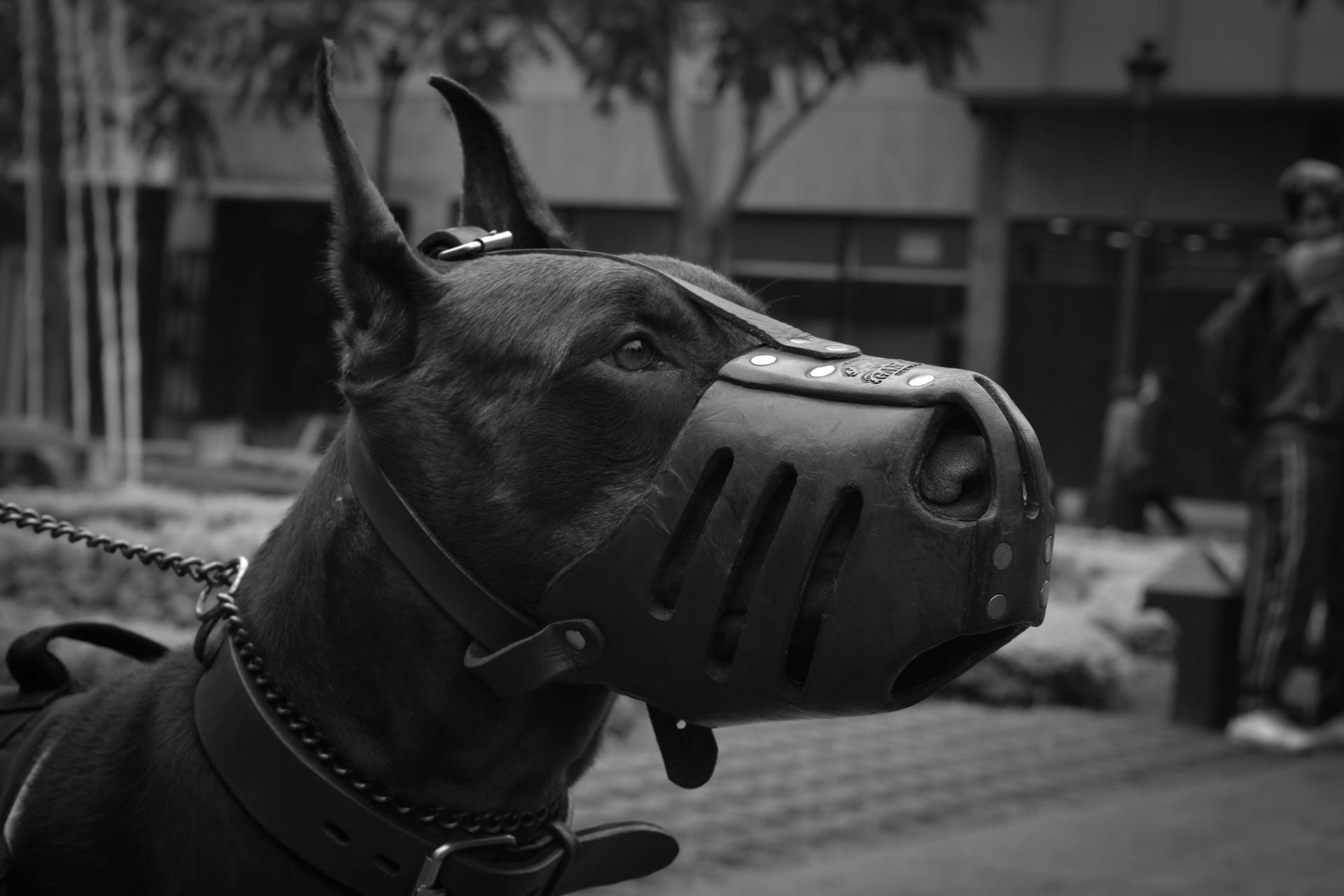
Dachshunds are a popular choice for apartment dwellers, but are they really a good fit? One major consideration is their exercise needs. They require at least 30 minutes of exercise per day, which can be challenging for busy apartment owners.
Dachshunds are relatively small in size, weighing between 16 and 32 pounds, but they have a big personality. Their short stature means they don't need a lot of space to run around, but they still need regular exercise to stay happy and healthy.
Their short legs also mean they're not built for long-distance running, but they can still get a great workout with short bursts of activity, such as playing fetch or going for a short walk.
You might like: Do Long Haired Dachshunds Need Haircuts
Are Dachshunds Suitable for Apartments?
Dachshunds can make great apartment dogs, especially if they get plenty of exercise and aren't left alone for too long.
They're relatively small in size, which makes them a perfect fit for apartments. In fact, they don't take up much space and are content with a compact area to eat, sleep, and play.
Dachshunds need at least 30 minutes of exercise a day, which can be achieved with a short walk around the block or some indoor playtime. For standard dachshunds, 60 minutes of exercise is recommended.
Living in an apartment with a dachshund requires some adjustments, such as using a lift or going up and down stairs to get in and out. You'll also need to consider your neighbors more, as people live above, below, and either side of you.
Potty training can be a bit more challenging in an apartment, but with a designated potty area and consistent routine, you can teach your dachshund to go potty outside. Positive reinforcement with treats and praise can help with this process.
Dachshunds are social animals and need regular socialization to prevent separation anxiety. Take them to dog parks or arrange playdates with other dogs to help them feel comfortable while you're away.
A cozy environment and a designated spot for their bed and toys can make a big difference in keeping your dachshund happy and content in an apartment. Providing a covered bed or a small nook where they can hide away can also help with their burrowing tendencies.
Exercise and Training
Exercise is crucial for Dachshunds to stay healthy and happy, with Standard Dachshunds needing about an hour of exercise daily and Miniature Dachshunds requiring at least 30 minutes. Regular walks and playtime are essential to keep them mentally and physically stimulated.
Playing fetch indoors using soft toys or balls is a great way to burn off excess energy, and setting up an obstacle course or agility course in your apartment can also be a fun and challenging activity for your Dachshund. However, it's essential to avoid high-impact exercises like jumping or running up and down stairs to prevent spinal injuries.
To prevent barking and destructive behavior, it's crucial to provide your Dachshund with regular exercise and mental stimulation, such as interactive puzzle toys or treat-dispensing toys. This will help keep them happy and healthy in an apartment setting.
Readers also liked: How to Prevent Ivdd in Dachshunds
Exercise Needs
Dachshunds need regular exercise to stay healthy and happy, even in an apartment setting. A great way to ensure regular exercise for your dachshund is by taking them for daily walks or jogs around the neighborhood or to a nearby dog park.
Take a look at this: How Much Exercise Do Dachshunds Need

Standard Dachshunds should get about an hour of exercise daily, while Miniature Dachshunds still need at least 30 minutes. Exercise can mean anything from a leisurely walk to an intense game of fetch, partly depending on the age of your dog.
Playing with your dog at home and engaging them mentally will also help to keep them in a happy and content state. Exercise is not the only reason you will have to take your dog outside, as they will need to go to the loo about five times a day.
Dachshunds have a predisposition to spinal injuries due to their long backs and short legs, so high-impact exercises like jumping or running up and down stairs should be avoided to prevent injury.
Training a Dachshund
Training a dachshund requires a commitment to regular routine and positive reinforcement. Establish a schedule for regular toilet breaks, as dachshunds need to wee when they wake and poo within about 20 minutes of eating. This will make housebreaking much easier.
Dachshunds respond well to positive reinforcement training, so be sure to reward them with treats and praise when they do their business in the right place. Consistency is key when training a dachshund, so stick to your routine.
Exercise is another critical aspect of training a dachshund. Regular walks and playtime are essential to keep them mentally and physically stimulated. Indoor activities, such as playing with toys or using a treadmill, can also be useful in meeting their exercise needs.
To address barking concerns in a small living space, teach your dachshund to be quiet. One method is to train them to bark on command and then teach them the "quiet" command. Positive reinforcement and consistency are crucial in this process.
Socialization is also essential for dachshunds, as they can suffer from separation anxiety. Get them accustomed to being alone for short periods by taking them to dog parks or arranging playdates with other dogs. This will help them feel comfortable while you're away.
Readers also liked: Are Clickers Good for Dog Training
Establish a Routine

Establishing a routine is crucial when it comes to training your dachshund for apartment living. A consistent schedule helps prevent accidents and makes potty training much easier.
Dachshunds need to wee when they wake and poo within about 20 minutes of eating, so it's essential to establish a routine that takes this into account. This means taking them out for regular toilet breaks, ideally every hour.
To create a routine that works for you and your dachshund, consider the following:
- Take your dachshund out for a walk or to a designated potty area immediately after meals and naps.
- Establish a consistent schedule for regular toilet breaks, such as every hour or after every playtime.
- Be prepared to adjust your routine as needed, especially during the potty training phase.
By following a consistent routine, you can help your dachshund feel more secure and reduce the likelihood of accidents. Remember, patience and consistency are key when training your dachshund for apartment living.
Barking in Apartments
Dachshunds are known for their vocal nature and can be prone to barking. With proper training and socialization, you can manage their barking tendencies and prevent excessive noise issues.
Barking can be a concern for both you and your neighbors, especially in apartments where noise can travel easily. You'll want to introduce your doxie to the changes of apartment life slowly and make sure they're comfortable with their new surroundings.
A fresh viewpoint: Dachshunds Barking Sounds
Providing your dachshund with enough exercise and mental stimulation is key to reducing barking. Set aside time for leash walks and activities to keep them engaged and happy. Reusable and washable pads can also help with accidents and messes.
If your dachshund is barking excessively, try giving them something to do, like a tennis ball or a treat-filled toy. This can keep them occupied for hours and reduce barking. Blankets and crates can also be helpful in keeping them calm and secure.
Seeking professional dog training can be a last resort if their barking doesn't seem to be under control. A qualified dog trainer can help you identify the root cause of the barking and teach you techniques to manage it.
Challenges and Solutions
Dachshunds can make good apartment dogs, but they do require some extra consideration. They need regular exercise to prevent pent-up energy, which can lead to irritating behaviors.
Living in an apartment can be different from living in a house, with more neighbors to consider and potentially more stairs to navigate. Dachshunds may need time to adjust to their new surroundings, but they can adapt to an apartment routine.
To prevent potty accidents, it's essential to establish a consistent potty training routine. Running a Dachshund puppy outside every hour during the potty training phase can be challenging, especially in an upstairs apartment with rainy days.
Expand your knowledge: All about Dogs Dog Training
Noisy Apartments
Living in an apartment with a dachshund can be a challenge due to the noise level. Dachshunds are known for their vocal nature and can be prone to barking.
Excessive barking can lead to complaints from neighbors and even legal trouble, so it's essential to manage their barking tendencies with proper training and socialization.
To minimize barking, provide your dachshund with a tennis ball or a treat-filled toy to keep them occupied. You can also try leaving the TV on with low volume or placing them in a crate for a short time to help them feel secure.
However, if your dachshund continues to bark excessively, you may need to seek professional dog training. A qualified trainer can help you develop techniques to address the issue.
Apartments can be noisy due to traffic, sirens, buses, and people, so it's crucial to introduce your dachshund to these changes slowly and make sure they're comfortable with their new surroundings.
Personality Traits

Dachshunds are incredibly loyal and loving dogs. They are also known for their stubbornness, but with proper training, they can become well-behaved apartment companions.
Their small size belies their fearless nature, making them protective of their owners and excellent watchdogs. However, this can sometimes manifest as excessive barking if not trained correctly.
Their loyal nature means they thrive on attention and interaction with their owners, so regular exercise and playtime is essential to prevent boredom and destructive behavior.
For another approach, see: Are Dachshunds Loyal
Can I Leave My Dachshund Alone All Day?
Leaving your dachshund alone all day can be a problem. Dachshunds don't cope well with long periods of solitude and may bark if they're bored or anxious.
If you're away from home for extended periods, you'll need to arrange for someone to check in on your dachshund. This could be a neighbor or a dog walker who can give them some attention and exercise.
Dachshunds love being with people, so it's best to have them join you at work or find a dog-friendly office space.
It Can Be a Hassle

Living in an apartment with a dachshund can be a challenge, especially when it comes to potty training. You'll have to take your dachshund out when he needs to pee.
Every time your dachshund needs to go out, you'll have to get yourself ready, put his lead on, and take him outside, which can be a hassle.
You can't just open the door and let him run out into the garden, unlike if you lived in a house.
Taking your dachshund for daily exercise can also be a bit more effort than in a house, where you could just open the door and let him run out.
Discover more: River Run Dachshunds
Size and Space
Dachshunds are a great fit for apartment living due to their small size. They typically stand between 5-9 inches tall and weigh between 7-32 pounds.
Their compact size means they won't knock into everything in your apartment, and they don't require a large space to roam. They're content with a cozy environment and can thrive in apartments with the right care.
Dachshunds have low exercise needs, but they still require regular physical activity. They can be entertained with indoor exercises like playing fetch or going for a short walk around the block.
For more insights, see: Different Sizes of Dachshunds
Size Comparison

Dachshunds come in two main sizes: miniature and standard. Miniature dachshunds are around 5-6 inches tall and weigh no more than 11 pounds.
Standard dachshunds are significantly larger, reaching 8-9 inches in height and weighing between 16 and 32 pounds.
Their small size is a major advantage for apartment living, as they take up less space and require less exercise than larger breeds.
Miniature dachshunds are particularly well-suited for small spaces, weighing in at 11 pounds or less and standing just 5-6 inches tall.
Standard dachshunds, on the other hand, are still relatively compact, making them a great choice for city dwellers with limited space.
In fact, both miniature and standard dachshunds are ideal for apartment living due to their small size and moderate exercise needs.
Take a look at this: Wiener Dog Size
Adapting to Small Spaces
Dachshunds are a great fit for small spaces because they're small in size and don't require a large living area. They're content with a cozy environment and can thrive in apartments.
Their low exercise needs make it easy to keep them entertained indoors. They can be happy with short walks around the block and indoor games like fetch and tug-of-war.
Dachshunds enjoy having a designated spot for their bed and toys, so providing a cozy bed and a few chew toys can make all the difference. A covered bed or a small nook where they can hide away can also be appreciated.
Their small size means they won't knock into everything in your apartment, and they don't need a large space to roam.
Related reading: Hot Dog Bed for Dachshunds
Key Takeaways
Dachshunds can thrive in apartments if their needs are met. This is because they have an adaptable nature that allows them to adjust to smaller living spaces.
Regular exercise is crucial for a dachshund's well-being. Aim for at least 30 minutes of physical activity per day to keep them happy and healthy.
Managing barking tendencies is essential for apartment living. This can be achieved through training and providing mental stimulation.
Choosing the right dachshund for apartment living is also important. Consider factors such as energy level and noise level when selecting a breed.
Apartment Living Essentials
Apartment living can be a great fit for dachshunds, but it's essential to consider a few key essentials to ensure a happy and healthy dog.
Exercise needs are crucial for dachshunds, and they require daily walks of at least 30 minutes to prevent obesity and other health issues.
A suitable exercise routine can be achieved with short, frequent walks throughout the day, making it manageable for apartment dwellers.
Dachshunds are also prone to barking, which can be a concern for apartment living. However, with proper training, they can learn to bark less and be more quiet.
Apartment Living
Dachshunds can thrive in apartments with the right care and attention. They are adaptable dogs that can live in small spaces, but they do require regular exercise and playtime to stay happy and healthy.
You'll need to be prepared to take your dachshund outside frequently for potty breaks, especially when they're still puppies. This can be challenging, especially if you live in a high-rise building or have to dash out the door quickly.
Dachshunds are prone to barking, which can be a concern for apartment dwellers. However, with proper training and socialization, you can manage their barking tendencies and prevent excessive noise issues.
To prevent barking, make sure to provide your dachshund with plenty of physical and mental stimulation. This can include indoor exercises like playing fetch or setting up an obstacle course.
If you're considering bringing a dachshund into your apartment, be prepared to spend extra time with them and provide more leash time to help them adjust to their new surroundings. This will help ensure a smooth transition and a positive experience for your dog.
Dachshunds can get restless and destructive if they don't receive enough exercise. Aim for at least 30 minutes of exercise for a miniature dachshund and 60 minutes for a standard dachshund to keep them happy and tired.
It's essential to consider noise levels when living in an apartment with a dachshund. Introduce your dog to city sounds gradually, and provide them with plenty of attention and exercise to help them cope with the noise.
Indoor Dog Potty
You can train your dachshund to potty indoors using puppy pads or a dog litter tray, but be aware that dachshunds are notoriously hard to toilet train.
Dachshunds hate getting wet and feeling cold, so they often refuse to go potty outside when it's raining or snowing.
Having a puppy is a big responsibility, and potty training can take time, especially when you live in an upstairs apartment.
Running a dachshund puppy outside every hour during the potty training phase from an upstairs apartment can set you and your puppy up for failure.
Fresh Patch Disposable Dog Potty gives your dog the 'real grass' experience and is an indoor disposable dog potty option that is dirt free, odor-free and eco-friendly.
You'll need to replace the potty patch every couple of weeks depending on the frequency of use.
The bigger the indoor dog potty, the better, as most little long dogs take a while to find the perfect potty position.
For your interest: When Do Dachshunds Calm down
Adding an indoor pet potty splash guard is a great idea, especially for male pups who lift their legs.
The Hompet Indoor Dog Potty option uses washable fake grass over a tray as an indoor dog potty option and includes a back splash shield for male pups.
The Lazzipet Indoor Dog Potty with Sides option uses washable fake grass or pads over a tray and easy to clean removable walls.
Here's an interesting read: Are Dachshunds Hard to Potty Train
Dogs in Building
Get to know your neighbors and tenants within your building so that you can network with other dog owners.
Dogs like to have companionship and maybe it's possible you can coordinate your dog walks with another dog so that your dachshund has someone to be friends with.
It's a good idea to consider hiring a teenager or retiree to walk your dog, as they may be more than happy to do so for a small amount of money.
You could also ask your neighbors if they'd be willing to dog-sit for you when you're away, which could be a big relief.
Sometimes, there is a teenager or retiree who would be more than happy to walk your dog.
Why Do Dogs Bark?
Dogs bark for a variety of reasons, and understanding these triggers can help you manage their behavior more effectively. Some common triggers include loneliness or boredom, anxiety or fear, excitement or playfulness, and protectiveness and territorial behavior.
Dachshunds, in particular, are prone to barking due to their strong protective instincts, which can be triggered by strangers or new environments.
Loneliness or boredom can cause dogs to bark excessively, so it's essential to provide them with plenty of attention and exercise.
Anxiety or fear can also lead to barking, especially if your dog is not properly socialized or if they're exposed to loud noises or other stressors.
If your dog is barking due to excitement or playfulness, it's often a sign that they need more physical or mental stimulation.
Here are some common reasons why dogs bark:
- Loneliness or boredom
- Anxiety or fear
- Excitement or playfulness
- Protectiveness and territorial behavior
Frequently Asked Questions
Are Dachshunds OK to be left alone?
Dachshunds can be left alone for short periods, but ideally no longer than 4-6 hours. The right amount of alone time depends on your dog's individual needs and personality.
Do Dachshunds bark a lot?
Yes, Dachshunds are known to bark frequently due to their original hunting breed background, where barking was a crucial skill for tracking prey. Their strong instinct to bark remains a characteristic of the breed.
Sources
- https://www.ilovedachshunds.com/can-dachshunds-live-in-apartments/
- https://www.marissarosedachshunds.com/are-dachshunds-good-for-apartments/
- https://www.dachshundstation.com/dachshund-small-apartment/
- https://www.dogster.com/dog-breeds/is-a-dachshund-a-good-apartment-dog
- https://homelabvet.com/2019/11/11/important-considerations-for-dachshund-apartment-living/
Featured Images: pexels.com


